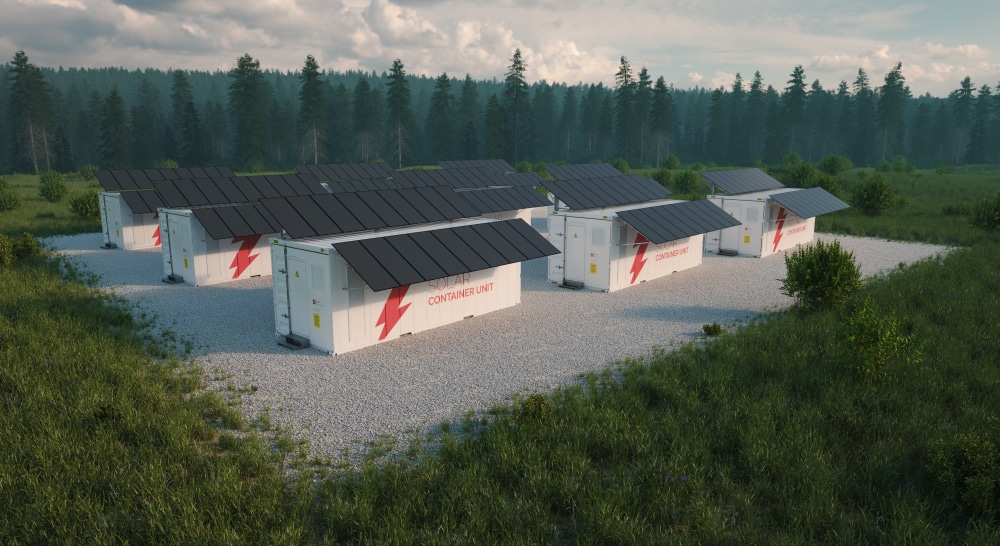SMARTESTORAGE Battery Energy Storage Systems (BESS) can be used in a variety of applications, including:
1. Grid-scale energy storage: SMARTESTORAGE can be used to store excess electricity generated from renewable sources (e.g., solar, wind) for later use, helping to balance the grid and improve the stability and reliability of the electricity supply. Customers can make money by selling stored excess electricity back to the grid during times of high demand, when electricity prices are typically higher. Furthermore, SMARTESTORAGE can help avoid curtailment of renewable energy generation and reduce the need for expensive grid infrastructure upgrades.
2. Microgrids: SMARTESTORAGE can be used to store electricity for use in a small, local power grid (microgrid) that is not connected to the main grid. This can be useful for remote or isolated communities that rely on renewable energy sources. Customers can generate and store electricity locally and sell it back to the grid, potentially earning revenue for excess electricity. SMARTESTORAGE can help reduce the need for expensive diesel generators and fuel transportation costs in remote or isolated sites.
3. Backup power: SMARTESTORAGE can be used to provide backup power in case of an outage or emergency. Customers can avoid costly downtime and lost revenue by using SMARTESTORAGE to provide backup power and to help avoid costly interruptions in operations or damage to equipment caused by power outages.
4. Peak shaving: SMARTESTORAGE can be used to reduce the demand for electricity during times of peak demand, helping to reduce the cost of electricity for consumers. SMARTESTORAGE can help reduce peak demand charges, which can make up a significant portion of electricity bills for commercial and industrial customers. Customers can save money on their electricity bills by radically reducing their energy consumption during peak hours when electricity rates are typically higher.
5. Electric vehicle (EV) charging: SMARTESTORAGE can be used to store electricity for charging EVs, reducing the demand on the grid and enabling the charging of a fleet of EVs simultaneously without inducing high peak demand charges, essentially providing an alternative to expensive upgrades of grid infrastructure to support EV charging.. Customers can provide charging services for EVs, potentially earning revenue and attracting more customers.
6. Commercial and industrial applications: SMARTESTORAGE can be used in commercial and industrial settings to store electricity for use during periods of high demand or to provide backup power. Customers can thus reduce their energy bills as well as avoid costly downtime. SMARTESTORAGE can help avoid costly interruptions in operations or damage to equipment caused by power outages, and can also reduce peak demand charges and avoid the need for expensive grid infrastructure upgrades.
7. Residential applications: SMARTESTORAGE can be used in homes to store electricity for use during periods of high demand or to provide backup power. Homeowners can save money on their energy bills by using stored electricity during peak hours, potentially reducing the need for expensive generators for backup power. Batteries reduce peak demand charges and provide an alternative to expensive upgrades of grid infrastructure to support EV charging or swimming pool heating.
8. Frequency regulation: SMARTESTORAGE can be used to provide fast response to changes in frequency on the grid, helping to maintain grid stability, thus helping to reduce the need for expensive traditional frequency regulation services.Customers can provide frequency regulation services to the grid, earning revenue for helping to maintain grid stability.
9. Transmission and distribution deferral: SMARTESTORAGE can be used to store excess electricity generated from renewable sources and release it onto the grid when demand is high, reducing the need for new transmission and distribution infrastructure. SMARTESTORAGE can help avoid costly grid infrastructure upgrades by reducing the need for new transmission and distribution lines to be built in order to meet peak demand. In addition, customers can sell stored excess electricity back to the grid during times of high demand, potentially earning revenue.
10. Renewable integration: SMARTESTORAGE can be used to store excess renewable energy and release it onto the grid when demand is high, helping to integrate renewable energy sources into the grid, and adding a stream of revenue for customers. SMARTESTORAGE can help avoid costly grid infrastructure upgrades by reducing the need for new transmission and distribution lines to be built in order to accommodate an increasing amount of renewable energy generation.
11. Ancillary services: SMARTESTORAGE can be used to provide various ancillary services, such as voltage support, to help maintain the stability and reliability of the grid and earning revenue for helping to maintain grid stability. SMARTESTORAGE can help reduce the need for expensive traditional ancillary services.
12. Military and disaster relief: SMARTESTORAGE can be used to provide portable power in military or disaster relief situations where access to the grid may be limited or disrupted. SMARTESTORAGE can help reduce the need for expensive and often unreliable diesel generators in military or disaster relief situations. Customers can provide portable power in emergency situations, potentially earning revenue and helping to provide critical services.
13. Telecommunication: SMARTESTORAGE can be used to store electricity for use in powering telecommunication equipment in remote or off-grid locations. SMARTESTORAGE can help reduce the need for expensive and often unreliable diesel generators in remote or off-grid locations where powering telecommunication equipment is necessary.
14. Agriculture: SMARTESTORAGE can be used to store electricity for use in irrigation systems and other agricultural applications where low power or no grid is available. SMARTESTORAGE can help reduce the need for expensive and polluting diesel generators.
15. Water treatment: SMARTESTORAGE can be used to store electricity for use in water treatment plants and other infrastructure in remote or off-grid locations. Costs are saved on not having to build out stronger power transmission lines.

